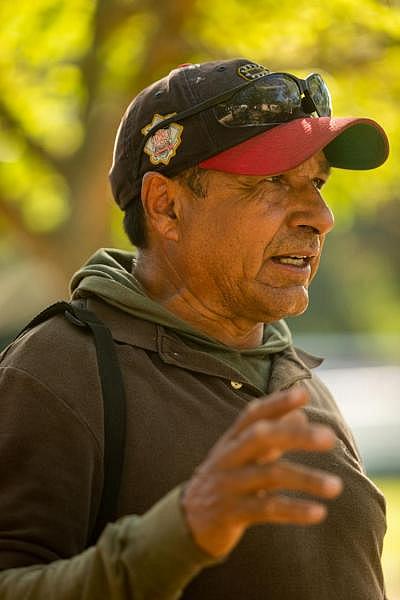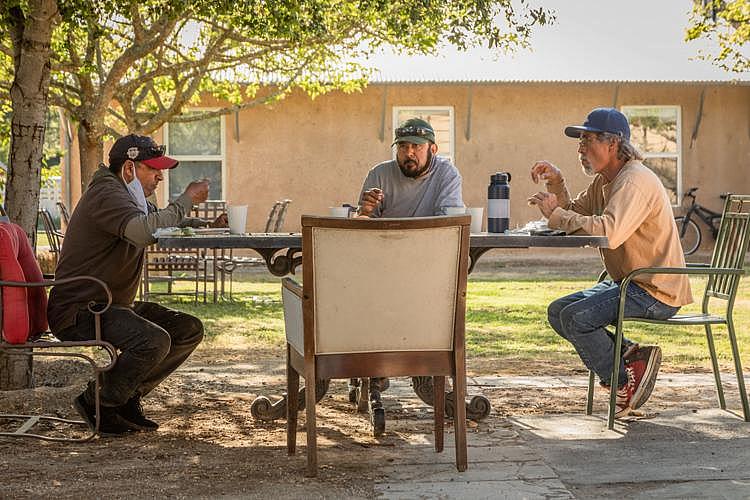Even if his employer did offer him health insurance, Jose Segura knows he wouldn’t be able to afford the monthly premiums.
Voices from the Vineyard: Cost complicates access to health care for Napa Valley's farmworkers
This story is part of a larger project series, "Voices from the Vineyard," led by Sarah Klearman, a 2021 Impact Fund grant recipient. She is reporting on how the twin crises of the pandemic and the wildfires have impacted the health of the valley’s farmworkers and their families.
Her other stories include:
Voices from the Vineyard, Part 1: 2020 harvest, cut short by North Bay wildfires, 'devastating' for wellbeing of farmworkers
Voices from the Vineyard, Part 3: Ahead of another fire season, Napa Valley's farmworkers face unknown health risk from more smoke exposure
Voices of Youth: The Waste of the World: Napa Valley must prioritize the health and personhood of its unhoused, by Rudolph Barragan
Voices of Youth: Showing up and moving forward; Napa's Hispanic community shows strength in time of crisis, by Carolina Padilla
Voices of Youth: Talking health equity: Reflecting on fire season working conditions for Napa Valley's farmworkers, by Paola Leon
Voices from the Vineyard, Part 4: Long quarantines inside Napa County-owned farmworker housing made residents feel isolated, anxious

River Ranch resident Jose Segura at the farmworker center in April. Segura, who does not have health insurance, makes too much money to qualify for MediCal, but not enough money to pay his own insurance premiums, he said
Clark James Mishler
Segura, 55, has worked as a farmworker for three decades; he’s spent the last two years a resident of the River Ranch Farmworker Center in St. Helena.
His wife and children live in San Joaquin County, Segura’s home during the off season. It’s a 120 mile round trip away, and the price of gas could outstrip the $420 he pays each month to live at River Ranch, Segura explained in Spanish. He comes to Napa because he prefers to work in the fields here: between early spring and late fall, the work is plentiful and comparatively well paid, he said.
The nature of seasonal work like the kind Segura does is such that wages matter to workers more than almost anything else, Segura said. That includes benefits like health insurance.
“Here, where many of us work for contractors, they do not offer us insurance,” he said, gesturing toward his fellow River Ranch residents as they ate an evening meal outside in April. “The problem is - if you, as a contractor, pay $17 an hour, and another contractor offers $18 an hour, I’ll go with him. For that reason, not many of us have insurance.”
Medical care is often prohibitively expensive for farmworkers, particularly for uninsured, undocumented workers, according to Herman Varela, a health educator with Dignity Health in Yolo County, from where many farmworkers make the seasonal commute to work in Napa Valley’s vineyards.
“The priority for the farmworker is not health - it is survival. It is work. It is providing for the family,” Varela, who worked for 20 years as a farmworker, said. The time it takes to receive care is also an obstacle, because an hour spent at the doctor’s office often translates into an hour's worth of lost wages for those workers, Varela said.
"Having been a worker myself, I know what you lack. One of the things we do not have is access to medical care," he said.
Just 12% of Napa Valley Grapegrower membership offered their seasonal employees health insurance in 2020, according to a members-only survey conducted by the group; around two-thirds of membership said they offered health insurance to regular employees. Those rates are high for California’s agricultural sector, Giovanni Peri, professor of economics at the University of California, Davis, told the Register in April of 2020.
Jose Gomez, 49, who has lived at the farmworker housing center for the last 14 years, uses his insurance to regularly see a primary care provider in Napa, in part because he has medical conditions that have required intensive medical treatment in the past, Gomez said. Still, he knows not all of his fellow residents utilize insurance the way he does.
“What happens here is they offer it to you, but many people here don’t enroll in it,” he said in Spanish. “Beyond health insurance, there’s workers compensation. If you have an accident while at work, the company will pay (for your care). That’s our insurance.”
Both Segura and Gomez are legal residents of the United States; both could enroll for MediCal, California’s Medicaid health care program, if they had qualifying income, according to Laurel Lucia, director of the Health Care Program at the University of California, Berkeley’s Labor Center. In Segura’s case, as he sought to explore insurance options for his family, he was told he and his wife earned too much to qualify for coverage for themselves and an 18-year-old daughter, who is still a dependent.
“I was like, well, ‘too much' ... what does that mean? I didn’t understand,’’ he said. Together, he and his wife have a combined income of around $50,000 annually, Segura said; to qualify for MediCal, a family of three would need to have a combined income of 138% the poverty level, according to Lucia, or around $30,000. It seemed arbitrary to Segura, who sometimes struggles to pay the bills he has even without the cost of premiums in the mix.
“I said to them, ‘tell me - how can I be making too much if I can’t afford (anything else)?’” Segura said.
Most reputable vineyard management companies do offer their employees insurance, according to Mike Wolf, who runs his own vineyard services company in Napa Valley. Not only is there a “practical need” for health insurance for farmworkers, he said - offering those benefits is “the right thing to do.”
Employees at Wolf’s own company do not qualify to enroll in benefits right away, he said: they must first work a certain number of hours over a period of 12 months. The hours threshold can be harder to cross for employees who join Wolf’s company only seasonally, according to Wolf, who said in recent years he’d lowered the number of hours needed to qualify to 1,200 from 1,700.
Those thresholds, which differ from company to company, are harder to cross for temporary, seasonal employees, Wolf said, noting he could not speak for other employers. If an employer is not offering any kind of insurance, he added, it’s undoubtedly because of the cost.
“Until a few years ago, we paid the full premium for our employees and their families. We didn’t take a nickel from them for really, really good coverage,” he said. But the cost of care began to rise and so did premiums, Wolf said. Depending on the type of coverage employees choose, they now contribute between 15% and 20% toward their own insurance premiums, and between 20% and 100% toward premiums for dependents.
It’s not that the premiums for the health insurance his employer offers him are especially egregious, according to Alejandro Bernal, a resident at the Mondavi Farmworker Center in Yountville: they would have cost him around $200 monthly. But Bernal turned it down, knowing that he’d be paying the premium on top of things like copays.
“The thing is that over the long term, that accumulates to be a lot,” he said in Spanish. It’s money he would rather send back to his family - his wife and children - in Mexico, he said.
Bernal, who has been a resident of the Yountville center for the last three years, has never seen a doctor in the United States; he might go to a doctor for a check up on a trip home to Mexico, where care is cheaper. The American health care system is good, Bernal said in Spanish, but it’s “quite expensive.”
Among low-income undocumented persons, the uninsured rate is almost 90%, Berkeley's Lucia said. Undocumented Californians, for example, can qualify for MediCal only if they are younger than 26; restricted MediCal, a more limited option, will in some cases cover emergency care and pregnancy care for low income, undocumented individuals, she said. Undocumented people cannot enroll in policies through the Affordable Care Act (ACA), including through Covered California.
“We get frustrated, because we can’t help. There is nothing for undocumented people. It’s very hard to find resources for them,” Varela said, adding that workers without legal status are “very, very common” among the farmworker population in Yolo County.
River Ranch resident Jose Segura at the farmworker center in April. Segura, who does not have health insurance, makes too much money to qualify for MediCal, but not enough money to pay his own insurance premiums, he said. Clark James Mishler
“Forty-eight percent of all Californians said they’re worried or somewhat worried about affording their monthly premium,” Lucia said, citing data from the California Healthcare Foundation. “That’s slightly more than the 45% who said they were worried about affording their rent or their mortgage.”
Uninsured Americans are more likely to seek medical care through community clinics and public hospitals, some of which offer care on a sliding scale of cost, according to Lucia. Napa County’s OLE Health, founded in the 1970s to serve the valley’s low income farmworker population, has taken on that role in Napa Valley, according to Patient Access Supervisor Maria Sanchez. Today, OLE takes all kinds of private insurance, she said, but its largest patient group are those who are uninsured, because those are often patients who are “looking for a place to come where they don’t have to pay a lot to receive care.”
OLE works with patients to determine if they might be eligible for MediCal or to purchase a policy through Covered California, the state’s Sanchez explained. OLE charges uninsured patients on a sliding scale based on income, she added. The clinic turns no patient away, according to spokesperson Jennifer Churchill, "regardless of insurance or ability to pay." Sometimes the challenge is simply making patients aware they might benefit from OLE Health’s services, Sanchez said.
Jose Segura, left, eats dinner with his fellow River Ranch residents. Neither Segura nor his wife or daughter have health insurance because the employer-offered and private-payer premiums are too costly for them to afford, Segura said, but he and his wife make too much annually to qualify for MediCal. Clark James Mishler
Without access to regular medical care, chronic illnesses like diabetes and hypertension, the result of high cholesterol, often go unchecked, Dignity Health’s Varela said.
“Those are sneaky illnesses, and (uninsured patients often) do not know they have them until they have symptoms, or they get really sick,” Varela said. “They might go to the emergency room, because that’s the only option they have. They’re only going when it’s absolutely necessary.”
Though Segura, the River Ranch resident, says he has researched private health insurance policies; coverage for himself, his wife and his 18-year-old daughter would be $500 a month, he says, a sum he simply cannot afford. In lieu of having insurance, he and his family try and take “good care” of themselves, Segura said, but he knows what they’re risking.
“I would prefer (affordable) health insurance over a dollar raise, a two dollar raise,” he said, looking around at his fellow River Ranch residents. “If you asked everyone here who would like a health insurance policy, one for which they could pay only $100 a month, everyone would want it. Every one.”
Register reporter Sarah Klearman reported this story with support from the Impact Fund, a program of the USC Annenberg Center for Health Journalism.
[This story was originally published by Napa Valley Register.]
Did you like this story? Your support means a lot! Your tax-deductible donation will advance our mission of supporting journalism as a catalyst for change.

